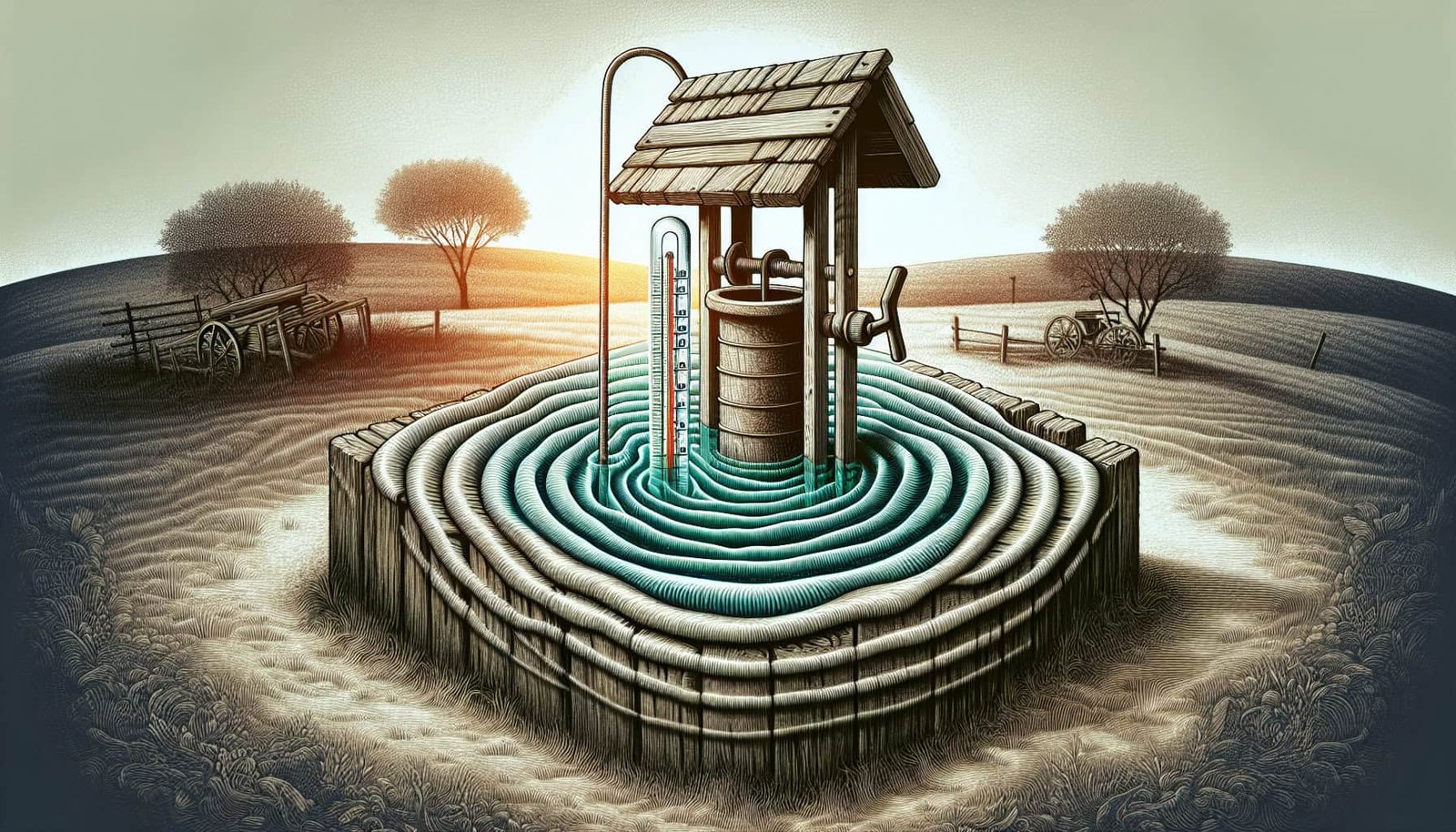If you are a well owner and have been experiencing fluctuations in your well water temperature, you may be wondering if there are any resources available to help you address this issue. Well, good news! You are not alone in facing this challenge, and there are indeed resources out there that can provide guidance and support. In this article, we will explore some of these resources and how they can assist you in understanding and managing well water temperature fluctuations. So, let’s dive in and discover what options are available to help you maintain a comfortable and consistent water temperature in your well.
Understanding Well Water Temperature Fluctuations
Well water temperature fluctuations can be a common issue that many well owners face. It is important to understand the causes and effects of these fluctuations in order to effectively manage and regulate the temperature of your well water. By testing and monitoring the temperature regularly, you can identify factors that may be impacting the temperature and take necessary steps to regulate it. This article will discuss the causes of well water temperature fluctuations, the potential risks and concerns, testing and monitoring methods, factors affecting well water temperature, regulating techniques, professional services available, maintaining water quality and safety, regulations and guidelines, important tips for well owners, and resources for further information.
Causes of Well Water Temperature Fluctuations
There are several factors that can contribute to well water temperature fluctuations. Some common causes include changes in the surrounding groundwater temperature, seasonal variations, geological and environmental factors, as well as well design and construction. Additionally, adjacent land use, such as the presence of nearby structures or industrial activities, can also affect the temperature of well water. It is important to identify the specific causes affecting your well in order to effectively address the issue.

Effect on Well Owners
Well water temperature fluctuations can impact well owners in various ways. Firstly, it can affect the comfort and convenience of using well water for daily activities, such as bathing or washing dishes. Fluctuating temperatures can make it difficult to maintain a consistent water temperature, leading to potential discomfort for well owners. Secondly, these fluctuations can also impact the overall performance and lifespan of well equipment and plumbing systems, potentially leading to increased maintenance or repair costs. Therefore, understanding and addressing well water temperature fluctuations is crucial for the well-being and satisfaction of well owners.
Potential Risks and Concerns
Apart from the inconvenience and potential impact on equipment, well water temperature fluctuations may pose certain risks and concerns. For instance, extreme temperatures can cause scalding or freezing injuries if the water becomes too hot or cold. Additionally, sudden changes in temperature may indicate other underlying issues with the well system, such as a malfunctioning pump or a leak in the plumbing. It is essential to address these concerns promptly to ensure the safety and functionality of the well system.

Testing and Monitoring Well Water Temperature
Regular testing and monitoring of well water temperature is vital for understanding the fluctuations and identifying potential issues. By conducting these tests, well owners can gather critical data that will help in determining the causes of temperature fluctuations and the most suitable solutions. It is recommended to establish a testing schedule to track any changes in temperature over time and compare the results with historical data. This will provide valuable insights and allow for proactive measures to be taken.
Importance of Regular Testing
Regular testing of well water temperature is essential for several reasons. Firstly, it allows you to establish a baseline for normal temperature levels in your well. This baseline will serve as a reference point for identifying any deviations or unusual fluctuations. Secondly, by monitoring the temperature regularly, you can identify trends and patterns that may coincide with specific seasons or changes in external factors. This information can be useful in understanding the causes and potential impacts of temperature fluctuations. Lastly, regular testing enables you to assess the effectiveness of any temperature regulation measures you may implement and make adjustments as necessary.

Methods for Testing Well Water Temperature
There are various methods available for testing well water temperature. One common approach is using a handheld thermometer specifically designed for measuring water temperature. These thermometers are easy to use and provide accurate readings. Another method involves using data loggers, which are devices that can be placed in the well to continuously monitor and record temperature data over an extended period. This method allows for more comprehensive data collection and analysis. Additionally, some well owners may choose to hire professional services that specialize in well water testing to ensure accurate and reliable results.
Monitoring Tools and Equipment
In order to monitor well water temperature effectively, it is important to have the right tools and equipment. Handheld thermometers, as mentioned earlier, are an essential tool for taking temperature measurements. These thermometers are widely available and relatively inexpensive. Data loggers, on the other hand, offer more advanced monitoring capabilities. These devices can be programmed to collect temperature data at specific intervals and can store a significant amount of information. Data loggers are particularly useful for long-term monitoring and trend analysis. Depending on the complexity of your well system and your monitoring needs, you can choose the appropriate tools and equipment to accurately monitor and track water temperature changes.

Factors Affecting Well Water Temperature
Several factors can affect the temperature of well water, and understanding these factors is crucial for effectively managing well water temperature fluctuations.
Depth and Location of the Well
The depth and location of a well can have a significant impact on its water temperature. Shallow wells, which have a depth of 30 feet or less, are more susceptible to temperature variations as they are more influenced by changes in external air temperature. On the other hand, deeper wells are less affected by daily temperature fluctuations but may still be influenced by seasonal changes or geological factors.
Seasonal Variations
Seasonal variations play a significant role in well water temperature fluctuations. During hot summer months, the temperature of the surrounding groundwater may increase, contributing to higher water temperatures in the well. Conversely, during colder winter months, the groundwater temperature may decrease, leading to colder well water. Understanding these seasonal patterns can help in developing appropriate temperature regulation strategies.
Geological and Environmental Factors
The geological and environmental characteristics of an area can affect well water temperature. For example, the presence of nearby bodies of water, such as rivers or lakes, can influence the temperature of the groundwater and, consequently, the well water. Additionally, the composition of the surrounding soil or rock layers can impact the transfer of heat to the well water. Understanding these factors can aid in identifying potential sources of temperature fluctuations.
Well Design and Construction
The design and construction of the well can also impact water temperature. For instance, wells with inadequate casing insulation or inadequate grout can be more susceptible to temperature variations. Well design choices, such as the use of certain materials or the placement of the wellhead, can also affect the temperature of the water in the well. It is important to consider these factors during the planning and construction phase of a well to minimize potential temperature fluctuations.
Adjacent Land Use
The activities and land use in the vicinity of a well can influence its water temperature. For example, the presence of nearby structures or paved surfaces that absorb and radiate heat can impact the temperature of the surrounding groundwater. Industrial activities or chemical storage facilities in the area can introduce pollutants that may affect well water temperature. Being aware of these potential influences can help in understanding and managing temperature fluctuations effectively.
Regulating Well Water Temperature
Once you have identified the causes of well water temperature fluctuations, there are several techniques and strategies for regulating the temperature and maintaining a comfortable and consistent water supply in your well.
Insulating Well Components
Insulating well components, such as the casing, can help in reducing temperature fluctuations. Insulation materials, such as foam or fiberglass, can be installed around the casing to minimize heat transfer between the surrounding environment and the well water. By creating a barrier to external temperature changes, insulation can effectively stabilize the water temperature and decrease the impact of seasonal variations.
Using Heat Exchangers
Heat exchangers are devices that transfer heat between two fluids without mixing them. They can be used to regulate the temperature of well water by extracting or adding heat from or to a separate source. For example, in colder months, a heat exchanger can utilize external heat sources, such as geothermal energy or solar energy, to warm the well water. In warmer months, the heat exchanger can extract heat from the water and cool it using a separate cooling system. Heat exchangers offer an energy-efficient and sustainable solution for maintaining desired water temperatures.
Recirculating Systems
Recirculating systems, also known as hot water recirculation systems, continuously circulate the well water to maintain a consistent temperature throughout the plumbing system. By recirculating the water, hot or cold water can be quickly delivered to any faucet or fixture, eliminating the need to run the tap for an extended period to achieve the desired temperature. This not only saves water but also reduces the amount of temperature variation experienced by well owners.
Geothermal Heating and Cooling
Geothermal heating and cooling systems utilize the stable temperature of the earth to regulate the temperature of well water. These systems extract heat from the earth during colder months and use it to warm the well water. Similarly, during warmer months, the heat is transferred from the well water to the earth, resulting in cooler water. Geothermal systems offer a sustainable and efficient method for maintaining a consistent and comfortable water temperature.
Alternative Energy Sources
Another option for regulating well water temperature is to utilize alternative energy sources. Solar panels, for example, can be installed to generate electricity or heat the well water directly. Wind turbines or hydroelectric systems can also be utilized to generate electricity for temperature control devices. By harnessing renewable energy sources, well owners can reduce their reliance on traditional energy sources and contribute to a more sustainable future.

Professional Services for Well Water Temperature Management
In some cases, well owners may require professional assistance to effectively manage well water temperature fluctuations. Several types of services are available to provide expertise and support in this area.
Well Contractors and Specialists
Well contractors and specialists have extensive knowledge and experience in well construction and maintenance. They can provide valuable guidance and recommendations for addressing temperature fluctuations specific to your well system. These professionals have the expertise to assess the well design, construction, and surrounding factors to identify any potential issues and implement appropriate solutions.
Water Treatment Companies
Water treatment companies specialize in addressing water quality issues, including temperature fluctuations. They can analyze the water composition and recommend suitable treatment methods to regulate the temperature and ensure safe and high-quality well water. Water treatment companies may also offer ongoing maintenance and monitoring services to ensure the long-term effectiveness of the temperature regulation system.
Consulting and Advisory Services
Consulting and advisory services can provide well owners with expert advice and guidance on managing well water temperature. These services often employ professionals with in-depth knowledge of well systems and water management strategies. They can assess the specific challenges faced by well owners and develop tailored solutions to address temperature fluctuations. Consulting and advisory services can be particularly beneficial for well owners seeking comprehensive and customized solutions.
Maintaining Water Quality and Safety
Temperature regulation is just one aspect of maintaining well water quality and safety. There are several other measures that well owners should consider to ensure clean and safe water.
Ensuring Proper Disinfection
Regular disinfection of the well system is essential for preventing bacterial growth and contamination. Well owners should follow recommended disinfection practices, such as chlorination, to eliminate any potential health hazards. It is recommended to consult with water treatment professionals or well contractors to ensure proper disinfection procedures are followed.
Water Filtration and Purification Systems
Installing water filtration and purification systems can further enhance the quality of well water. These systems can remove impurities, such as sediments, chemicals, or microorganisms, that may be present in the well water. Well owners should choose filtration and purification systems that are appropriate for their specific water quality concerns and regularly maintain and replace filter cartridges as needed.
Periodic Water Testing
Periodic water testing is crucial for identifying any changes in water quality that may affect its safety. In addition to testing for temperature, well owners should conduct comprehensive water quality tests to monitor for potential contaminants. By conducting periodic testing, well owners can address any issues promptly and ensure the ongoing safety and quality of the well water.
Addressing Bacterial or Chemical Contamination
If bacterial or chemical contamination is suspected in the well water, immediate action should be taken to mitigate the risks. In such cases, it is advisable to consult with water treatment professionals or well contractors to determine the most effective treatment methods. Promptly addressing any contamination concerns is vital for protecting the health and safety of well owners.
Well Water Temperature Regulations and Guidelines
There are various regulations and guidelines in place to ensure the proper construction, maintenance, and operation of wells. Well owners should familiarize themselves with these regulations to ensure compliance and best practices.
Local and State Regulations
Local and state government agencies typically have regulations in place that dictate the construction and operation of wells within their jurisdiction. These regulations may include guidelines on well design, location, and maintenance. Well owners should familiarize themselves with these regulations and ensure that their well complies with all applicable requirements.
Health Department Guidelines
Health departments often provide guidelines and recommendations for well owners to ensure the safety and quality of well water. These guidelines may cover topics such as well disinfection, water testing, and maintenance practices. Well owners should consult their local health department or relevant authorities to access these resources and obtain up-to-date information on best practices.
Water Well Construction Standards
Water well construction standards established by professional organizations or industry associations offer guidance on well construction practices. These standards often include recommendations for well design, casing materials, grouting methods, and other aspects related to temperature control and overall well performance. Well owners should refer to these standards when planning and constructing a new well or when making modifications to an existing one.
Important Tips for Well Owners
As a well owner, there are several important tips to keep in mind for effectively managing well water temperature fluctuations.
Educating Yourself about Well Systems
It is important to educate yourself about the basics of well systems and the factors that can impact well water temperature. This knowledge will help you better understand and address any temperature fluctuations that may occur. Familiarize yourself with well construction and maintenance practices, as well as any regulations or guidelines applicable to your area.
Maintaining Regular Maintenance and Inspections
Regular maintenance and inspections are crucial for ensuring the optimal performance of your well system. Schedule periodic checks of the well components, including the casing, pump, and plumbing, to identify any signs of damage or potential issues that may affect water temperature. Addressing these issues early on can prevent more significant problems down the line.
Considering Professional Help when Needed
If you are unsure about how to address temperature fluctuations or encounter complex issues with your well system, do not hesitate to seek professional help. Well contractors, water treatment companies, or consulting services can provide expert advice and assistance tailored to your specific needs.
Being Proactive in Addressing Temperature Fluctuations
Temperature fluctuations should not be ignored or taken lightly. Be proactive in addressing any changes or irregularities in well water temperature. Regular monitoring, testing, and maintenance will help you identify and address any potential issues before they escalate. By staying proactive, you can ensure the longevity and reliability of your well system.
Online Communities and Forums for Well Owners
Being part of online communities and forums dedicated to well owners can provide valuable insights, advice, and support. Connecting with other well owners allows you to learn from their experiences, share your own challenges and successes, and exchange tips and recommendations. These communities are a great resource for finding practical solutions to temperature fluctuations and navigating other issues related to well ownership.
Connecting with Other Well Owners
There are numerous online platforms and forums where well owners connect and share their experiences. Joining these communities will allow you to connect with others facing similar challenges and develop a network of support and information exchange.
Sharing Experiences and Insights
Participating in online discussions and sharing your own experiences and insights can be beneficial for both yourself and other well owners. By sharing your knowledge and lessons learned, you can contribute to the collective understanding of well water temperature fluctuations and help others facing similar issues.
Seeking Advice and Support
Online communities provide a platform for well owners to seek advice and support when dealing with well water temperature fluctuations. If you are facing a specific challenge or have questions regarding temperature regulation, these communities can offer valuable input, recommendations, and resources. Additionally, discussing your concerns with a community of like-minded individuals can help alleviate any stress or frustrations associated with well water temperature fluctuations.
Educational Resources and Websites
There are numerous educational resources and websites available to further expand your knowledge on well water temperature regulation and related topics. These resources are often provided by government agencies, non-profit organizations, technical institutions, and research institutions.
Government Agencies and Extension Services
Government agencies, such as the Environmental Protection Agency (EPA) or the Department of Natural Resources, often provide information and resources related to well water management. Additionally, Extension Services, which are part of land-grant universities, offer educational programs and materials on various agricultural and natural resource topics, including well systems and water management.
Non-profit Organizations
Non-profit organizations focused on water conservation and management often provide valuable educational resources for well owners. These organizations may offer informative articles, guides, or webinars to help well owners understand and address well water temperature fluctuations.
Technical and Research Institutions
Technical institutions and research institutions often conduct studies and research on well systems and water management. Their findings and publications can provide detailed insights into temperature regulation techniques and best practices. Exploring the websites of these institutions can provide access to valuable resources and research papers on the topic.
In conclusion, understanding well water temperature fluctuations is crucial for well owners to effectively manage and regulate the temperature of their well water. By identifying the causes, testing and monitoring regularly, and implementing appropriate regulating techniques, well owners can ensure a comfortable and consistent water supply. It is important to also consider maintaining water quality and safety, adhering to regulations and guidelines, and seeking professional help when needed. By staying proactive, staying informed, and connecting with other well owners, you can successfully navigate the challenges associated with temperature fluctuations and enjoy the benefits of owning a well.
Total words: 3079

